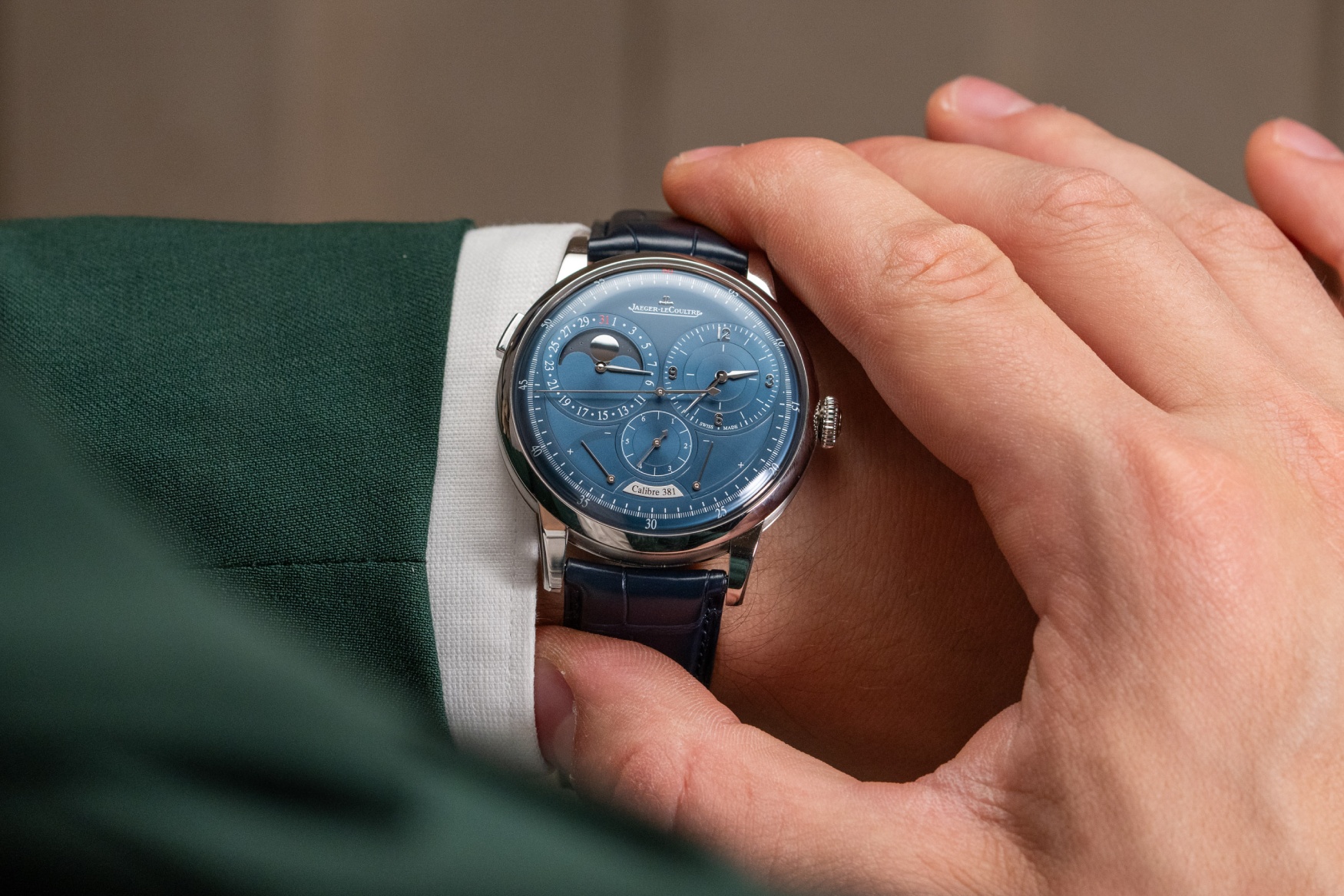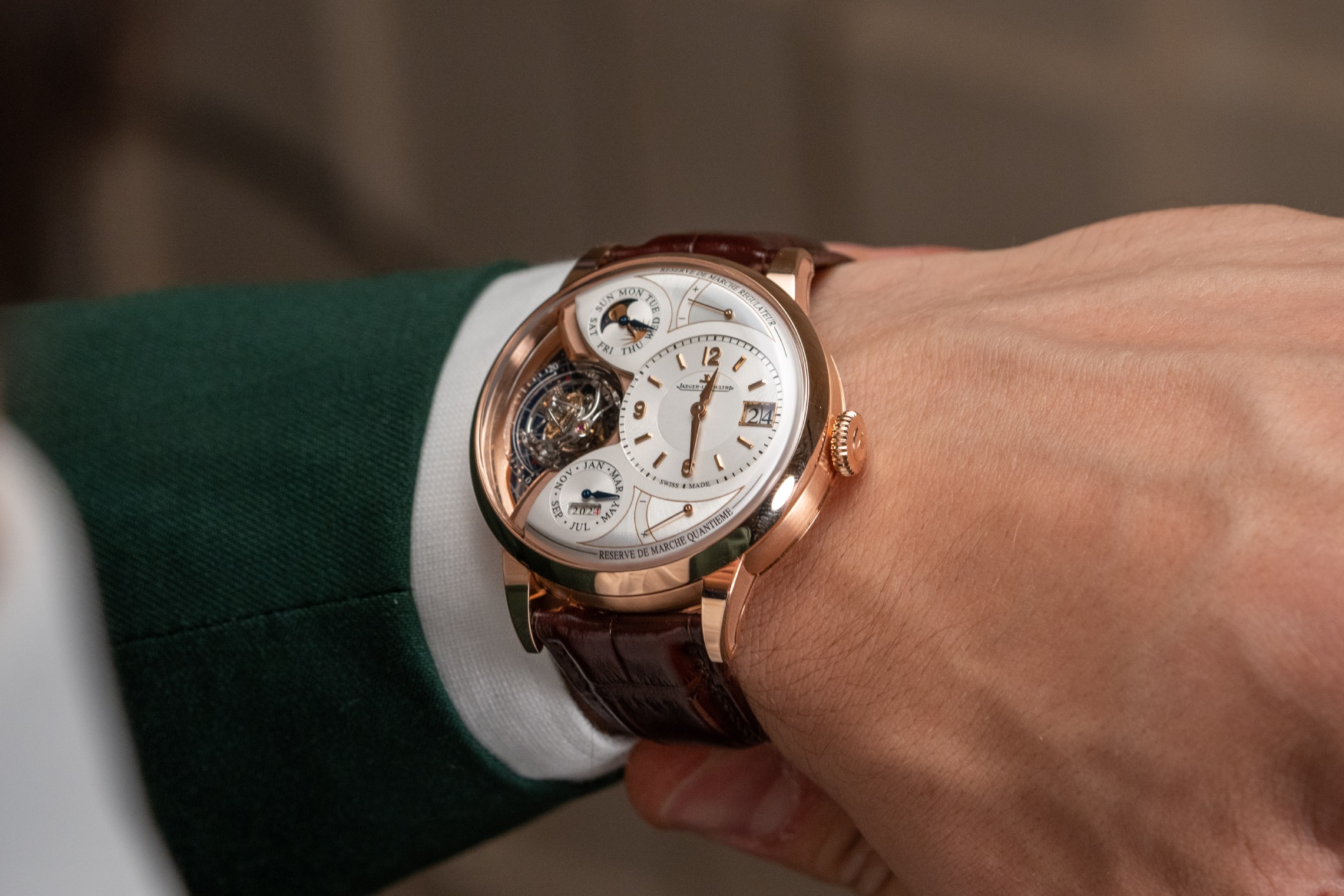
Aside from the technical advancements, JLC is proud of the improvements they made to the Duomètre case. Due to the complexity and size of the movement housed inside, the Duomètre was never a particularly svelte watch. The Heliotourbillon Perpetual is actually larger than the somewhat related Spherotourbillon. The pink gold case is 44mm in diameter, 14.7mm tall, and is fitted with a box-domed sapphire crystal on top. But the coolest part is the sapphire window on the side of the case, which exposes as much of the Heliotourbillon as possible.


At 42.5mm in diameter and 14.2mm thick, the Chronograph Moon is slightly smaller in diameter, but in platinum it’s roughly the same thickness as the HelioTourbillon Perpetual, making it feel a little unwieldy. It has the same finish as its siblings in the collection, with expertly brushed and polished surfaces. My favorite features are the lugs, which have a frosted center and a thin reflective strip that outlines their claw-like shape.


As with the dial, the Quantième Lunaire is once again the most ordinary watch. The case is made from steel and is 42.5mm in diameter with a height of 13.05mm. The Quantième Lunaire fits most comfortably on wrists between 15.5-16cm, mainly due to the lighter weight of the steel, but those with average or larger wrists (like the watch modelled by Pietro above) will have no problem wearing any of the three. Finishing is done to the same standard across the collection, while both the Quantième Lunaire and Chronograph Moon are water resistant to 50m. Just to be on the safe side, we wouldn’t recommend going near any water deeper than your ankles.
strap


All three Duomètre models are fitted with alligator leather straps lined with a small layer of alligator leather, offering the comfort you expect from a premium strap, and finished with a pin buckle that matches the case.
Movement


Before delving into the specifics of each movement, it’s worth discussing how the Duomètre works in the first place. The concept revolves around JLC’s Dual Wing technology, which involves two independent gear trains regulated by a single escapement and controlled by the collection’s signature jumping seconds mechanism. Each gear train is driven by a separate barrel, so timekeeping is not interrupted by any additional complications. All Duomètre models also feature the distinctive Côtes Soleil, another JLC patent that refers to the striped decoration emanating from the regulator. While reading through the press materials, a description of JLC’s hand-beveled and polished angles stood out to me. This is only mentioned in relation to the Heliotourbillon. Upon closer inspection, the sharp outward angles and slight inward angles reveal a more advanced finish, but it would be nice if JLC would give the same attention to the other two Duomètre models.
Let’s start with the big guns. This also introduces a completely new type of tourbillon to JLC, where a secondary barrel is responsible for the Heliotourbillon and the perpetual calendar with grand date complication. I can already hear you asking: “Gyrotourbillon, Sphérotourbillon, Heliotourbillon. Have these become JLC buzzwords?”, but no. They all define different technologies and I won’t go too deep into them here, but Gyro and Sphérotourbillon refer to different types of dual-axis tourbillons, the latter with a spherical balance spring (unless you consider the Gyrotourbillon II, which also has a spherical balance spring). The Heliotourbillon adds a third axis with three cages perpendicular to each other and a cylindrical balance spring. The first two make one rotation in 30 seconds and the third one per minute. The entire titanium assembly is made up of a whopping 163 parts, but weighs just 0.7 grams. The JLC Caliber 388 is manually wound and has a layout very similar to that of the Duomètre Spherotourbillon from ten years ago, but now equipped with a new three-axis mechanism. It beats at 4 Hertz and has a power reserve of 46 hours per barrel.


Moving on to the chronograph caliber 391, which JLC says was built from the ground up specifically for the Duomètre Chronograph Moon. At first glance, it looks very similar to the Cal. 380 used in previous Duomètre Chronographs, but the new 391 adds two important new complications: moon phase and day/night indication. The result is an integrated monopusher chronograph with a 50-hour power reserve per barrel. JLC also highlights the openworking done for Cal. 391, which serves both aesthetic and functional purposes, as it simplifies the assembly process. The bridges and wheels are not as airy as you would expect from a properly skeletonized movement, but that’s mainly because the mechanism is so compact. After all, JLC has to fit two separate gear trains and barrels here. On that note, I’d love to see someone try to skeletonize these barrels with a bidirectional ratchet.


And now, in our third instalment in this series, we have the Duomètre’s technology at its simplest. While the moon phase is indeed a complication, the Duomètre cannot just display the time, as that would defeat its purpose. In any case, the Quantième Lunaire follows the same barrel layout as the Chronograph Moon, but this one is even more obscured from view and has a large sunburst striped plate covering the gear train. As with the Chronograph Moon, each barrel stores a 50-hour power reserve, and the date function is operated by a large rectangular pusher at 10 o’clock. The Quantième Lunaire is the only new Duomètre that does not feature a new movement, reusing the caliber 381 that first appeared when the model was introduced in 2010.
Verdict


I’m really happy that Jaeger-LeCoultre is once again paying attention to the Duomètre collection. The trio covers both extremes, with new models in between that utilize the brand’s patented technologies in new ways. What I’m less excited about, however, is the absence of German silver in the movement. This, combined with the still-non-existent sharp interior and exterior angles, feels like a bit of a downgrade.
Now, let’s get to the specific models. The Heliotourbillon is hands down the best, but it’s not just a great watch, it’s a damn awesome watch. The case is big and chunky (calm down), and we haven’t even mentioned the $500,000 price tag yet. It also lacks what I love most about the Duomètre: the 1/6th second hand foudroyante movement. That being said, while it may not be my favorite of the three, the Duomètre revival needed a star player, and the Heliotourbillon Perpetual is that star player.

That leaves the Chronograph Moon and the Quantième Lunaire. The latter is the entry model in the Duomètre collection, but at $44,300 USD, it’s not exactly affordable. The patented dual barrel technology is certainly impressive, but I’m not sure the Quantième Lunaire makes the most of it. By simple elimination, the only model left is the Chronograph Moon, which is my favorite. The Chronograph is an original Duomètre model created to solve the problem of famously power-hungry complications. When in operation, most of the dial moves, making it a sight to behold. If I were to choose a luxury platinum chronograph to spend money on (I won’t, to be honest), and for those who find the Daytona and Patek Philippe 5905P a bit niche and not high-tech, the answer would be the Duomètre Chronograph Moon.
Pricing and availability of the Jaeger-LeCoultre Duomètre Watches & Wonders 2024 collection
All watches in the Jaeger-LeCoultre Duomètre 2024 collection are available now. The Duomètre Héliotourbillon Perpetual is limited to 20 pieces. Price: USD 44,300 (Quantième Lunaire), USD 86,000 (Chronograph Moon), USD 438,000 (Héliotourbillon)
Brand Jaeger-LeCoultre Model Duomètre Heliotourbillon Perpetual
Duometre Chronograph Moon
Duomètre Quantième Lunaire Case dimensions 44mm (D) x 14.7mm (T) (Heliotourbillon)
42.5mm (D) x 14.2mm (T) (Chronograph Moon)
42.5mm (D) x 13.05mm (T) (Quantième Lunaire) Case Material 18K Pink Gold (Heliotourbillon)
950 Platinum (Chronograph Moon)
Stainless steel (Quantième Lunaire) Water resistant to 30 meters (Heliotourbillon)
50 Meter (Chronograph Moon, Quantieme Lunaire) Crystal Domed Sapphire Front, Sapphire Back Dial Silver Opaline (Heliotourbillon)
Copper Opaline (Chronograph Moon)
Blue Opaline (Quantième Lunaire) Bracelet Alligator leather, clasp matching the case Movement JLC 388, in-house made, hand-wound (Heliotourbillon)
JLC 391, in-house, manual winding (Chronograph Moon)
JLC 381, in-house made, hand-wound (Quantième Lunaire) Power reserve 46 hours per barrel (Heliotourbillon)
50 hours per barrel (Chronograph Moon, Quantième Lunaire) Functions Hours, minutes, seconds, Heliotourbillon, perpetual calendar with grand date (Heliotourbillon)
Hours, minutes, seconds, 1/6 seconds, chronograph, moon phase, day/night indicator, power reserve (chronograph moon)
Hours, minutes, seconds, 1/6 seconds, moon phase, date, power reserve (Quantieme Lunaire) Available now
20 pieces (Heliotourbillon) Price: US$44,300 (Quantième Lunaire)
$86,000 (Chronograph Moon)
US$438,000 (HelioTourbillon)
